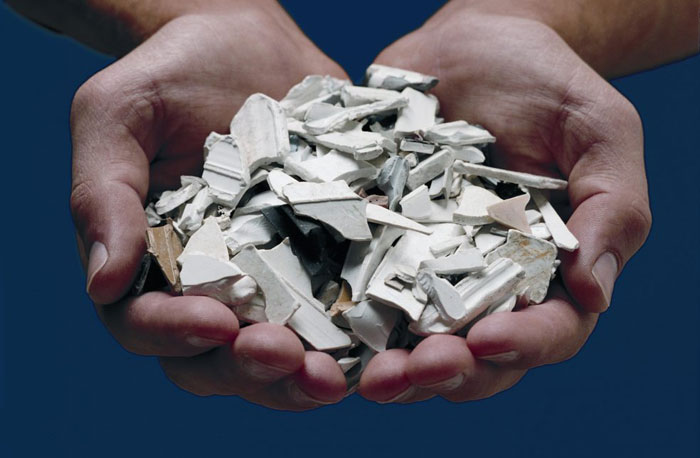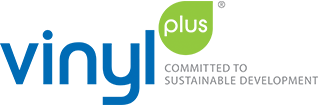PVC recycling in Germany
Used PVC products are far too good to throw away. In order to conserve valuable resources, the PVC industry has therefore organised the recycling of the most important PVC products and is also setting itself ambitious goals for the future in this area.
Industry uses significantly more recyclates
Despite the adverse economic conditions, the German PVC industry has made further significant progress towards a functioning circular economy. This is shown by the current material flow diagram for PVC in Germany 2021, jointly commissioned by VinylPlus Deutschland and PlasticsEurope Deutschland. According to this, 340,000 tonnes of PVC recyclates plus 1.57 million tonnes of virgin PVC were processed into semi-finished and finished products in Germany. This means that the use of recycled PVC increased by a total of 91,000 tonnes compared to 2017. This is a very significant growth of almost 37 per cent compared to 2017. Despite a decline in the use of virgin PVC, the total PVC processing volume of 1.91 million tonnes was thus also 3.8 per cent higher than in 2017. "Almost 18 per cent of the PVC processed in Germany is now obtained from recycling. Recyclates are already an important raw material base for us, which we use to reduce the use of fossil raw materials. In the transition to a CO2-neutral economy by 2050, closed material cycles will be of great importance. We are on the right track here," says VinylPlus Germany Managing Director Thomas Hülsmann.
The recycled materials produced through mechanical recycling are used primarily in building products such as windows or other building profiles, pipes or traffic safety applications. Long-life applications, in other words, which have already made up the dominant share in processing for a long time. In 2021, the construction sector was again the largest application area, accounting for more than 75 percent of the total processed PVC of 1.91 million tonnes.
Compared to 2017, the volume of PVC waste increased by almost 24 percent to 861,000 tonnes in 2021. This increase is determined in particular by the increasing return of durable building products, which have been increasingly installed since the 1970s and 1980s. The amount recycled also increased significantly in the same period: 854,000 tonnes of PVC were recycled in 2021, almost 170,000 more than in 2017. Broken down by recycling method, the amount breaks down as follows: 42 percent of the PVC waste was recycled materially and 57 percent under energy recovery, for a total of 99 percent.
The export of waste plays virtually no role in the case of PVC. Only 10,000 tonnes were exported for recycling almost exclusively to EU countries in 2021.
About the study
For the study entitled "Material flow diagram PVC in Germany 2021 - Facts and figures on the life cycle of PVC", more than 2,000 companies from plastics production, processing and recycling were surveyed and official and other statistics were used. The study was commissioned by VinylPlus Germany and PlasticsEurope Germany and carried out by Conversio Market & Strategy GmbH. The study is available on request from VinylPlus Germany.

Material recycling
Material recycling has been common practice in PVC production and processing for many decades. The majority of unmixed waste is returned directly to production. For the recycling of post-consumer waste, the PVC industry has developed a number of initiatives since the early 1990s that are firmly established in the market.
In waste management, construction products are the most important PVC waste in terms of volume. In Germany, the Arbeitsgemeinschaft PVC-Bodenbelag Recycling (AgPR) or the Industrieverband Kunststoffbahnen Europe e.V. (tarpaulins, membranes, tents and artificial leather) take care of this waste. For windows, Rewindo GmbH has set up a nationwide take-back system with its recycling partners. Finally, the Kunststoffrohrverband e.V. (KRV) has been promoting mechanical recycling for many years and, together with PreZero Kunststoffrecycling GmbH & Co.KG in Börde-Hakel, ensures the recycling of plastic pipe waste. The PVC industry in Germany also cooperates with the European Recovinyl initiative founded by VinylPlus®.
Recycling offers are also available for packaging, cables, credit cards and mixed PVC waste. These and a variety of recycling products are listed in the PVC Recycling Finder. With its sustainable take-back and recycling schemes for its end-of-life products, the PVC industry is making a major contribution to resource efficiency and sustainable business.
Raw material and chemical recycling
Hydrogen chloride can be obtained in pure form through the thermal treatment of PVC products. The hydrocarbon content in the PVC is used in the same process to generate heat or electricity. In chemical recycling, pyrolysis oil or synthesis gas is produced from the proportionate material flow of the hydrocarbons. The hydrogen chloride, for example, can be recycled back into PVC production. These raw material and chemical processes are divided into processes with and without chlorine limitation. The recycling process without chlorine limitation is particularly suitable for contaminated and PVC-rich mixed plastic fractions. The PVC industry has been investigating suitable technologies for feedstock recycling of PVC-rich waste streams since 1992, mainly at European level. The input for the chemical and feedstock processes should be limited to mixed and dirty PVC waste, and should not include PVC waste from separate collection for which there are established mechanical processes. Overall, however, feedstock and chemical plastics recycling is still under development.
